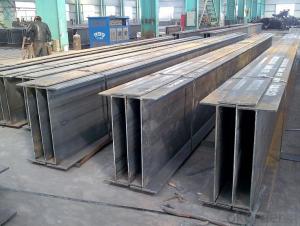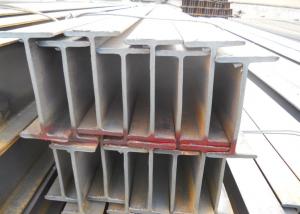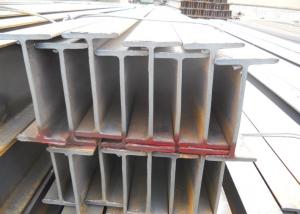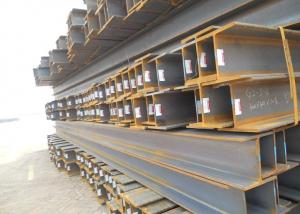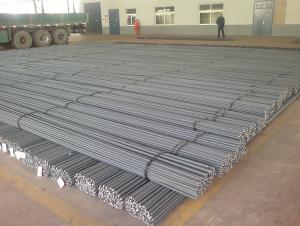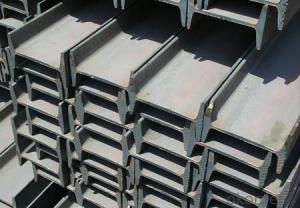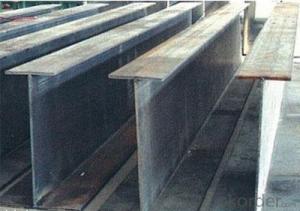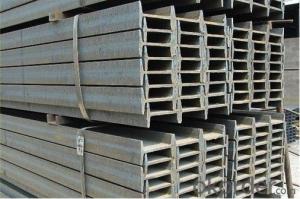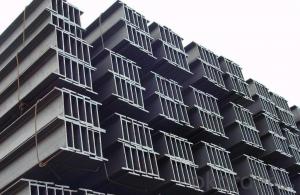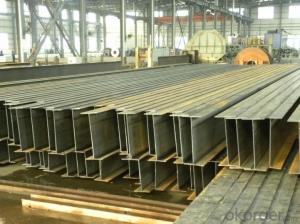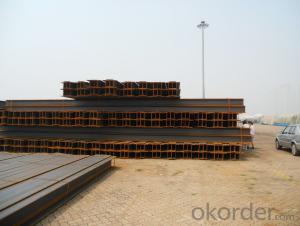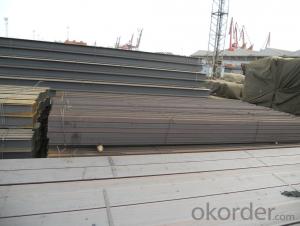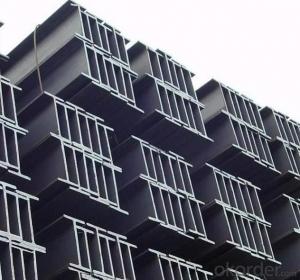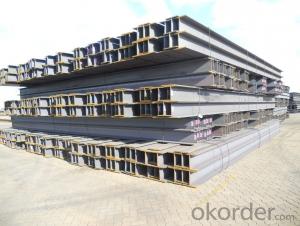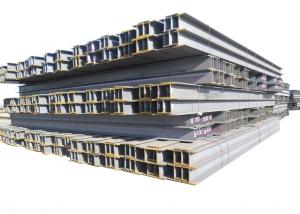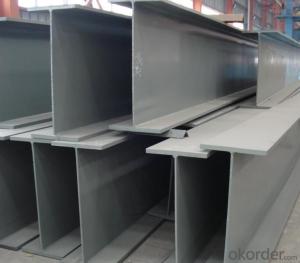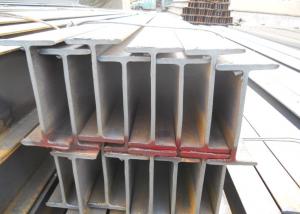Japanese Standard SS400 H beam with High Quality 400mm-428mm
- Loading Port:
- Tianjin
- Payment Terms:
- TT OR LC
- Min Order Qty:
- 100 m.t
- Supply Capability:
- 15000 m.t/month
OKorder Service Pledge
OKorder Financial Service
You Might Also Like
Specification
Specifications of Japanese Standard SS400 H beam with High Quality 400mm-428mm:
1. Standard: JIS 3192
2. Grade: SS400 or Equivalent
3. Length: 10m, 12m as following table
4. Invoicing on theoretical weight or actual weight as customer request
5.Payment: TT or L/C
Size and Mass of Japanese Standard SS400 H beam with High Quality 400mm-428mm:
| Size(mm) | Mass (Kg/m) | Size (mm) | Mass (Kg/m) |
| 400*400*13.0 | 172 | 414*405*18.0 | 232 |
| 400*408*21.0 | 197 | 428*407*20.0 | 283 |
Packaging & Delivery of Japanese Standard SS400 H beam with High Quality 400mm-428mm for Building Structures:
1. Packing: it is nude packed in bundles by steel wire rod
2. Bundle weight: not more than 3.5MT for bulk vessel; less than 3 MT for container load
3. Marks:
Color marking: There will be color marking on both end of the bundle for the cargo delivered by bulk vessel. That makes it easily to distinguish at the destination port.
Tag mark: there will be tag mark tied up on the bundles. The information usually including supplier logo and name, product name, made in China, shipping marks and other information request by the customer.
If loading by container the marking is not needed, but we will prepare it as customer request.
4. Transportation: the goods are delivered by truck from mill to loading port, the maximum quantity can be loaded is around 40MTs by each truck. If the order quantity cannot reach the full truck loaded, the transportation cost per ton will be little higher than full load.
5. Delivered by container or bulk vessel.
FAQ:
Q1: Why buy Materials & Equipment from OKorder.com?
A1: All products offered by OKorder.com are carefully selected from China's most reliable manufacturing enterprises. Through its ISO certifications, OKorder.com adheres to the highest standards and a commitment to supply chain safety and customer satisfaction.
Q2: How do we guarantee the quality of our products?
A2: We have established an advanced quality management system which conducts strict quality tests at every step, from raw materials to the final product. At the same time, we provide extensive follow-up service assurances as required.
Q3: How soon can we receive the product after purchase?
A3: Within three days of placing an order, we will arrange production. The shipping date is dependent upon the quatity, how many sizes you want and the plan of production, but is typically 1 month to 2 months from the beginning of production.
Images of Japanese Standard SS400 H beam with High Quality 400mm-428mm:
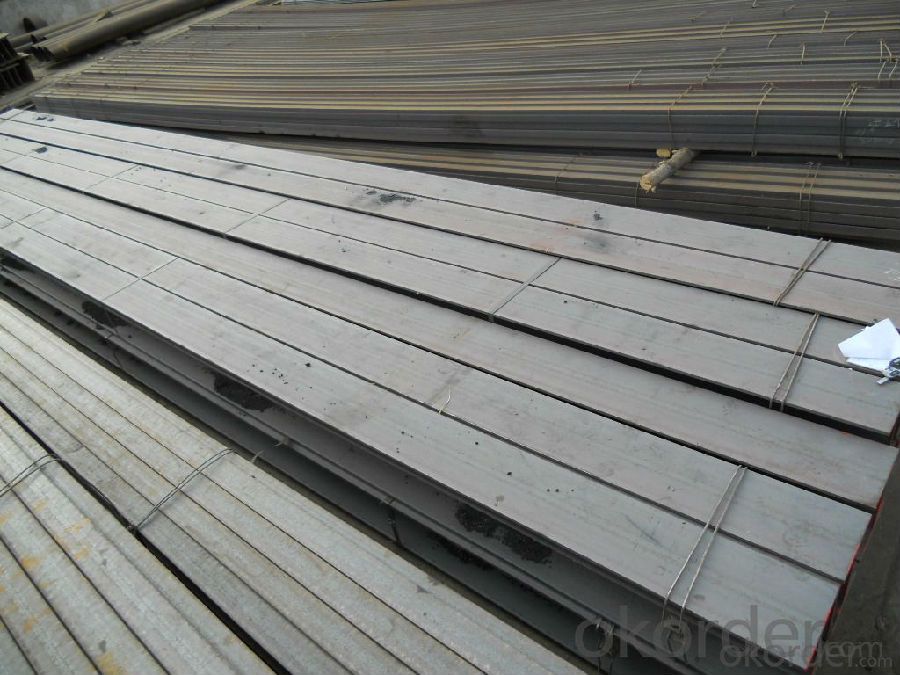

* If you would like to get our price, please inform us the size, standard/material and quantity. Thank you very much for your attention.
- Q: What is the maximum load capacity of steel H-beams?
- The maximum load capacity of steel H-beams can vary depending on various factors such as the size, shape, and grade of the beam, as well as the span and support conditions of the specific application. Steel H-beams are designed to withstand heavy loads and are commonly used in construction and structural engineering projects. It is essential to consult engineering professionals or refer to structural design guidelines and load tables provided by manufacturers to determine the specific maximum load capacity for a given steel H-beam.
- Q: Are steel H-beams suitable for buildings with heavy machinery or equipment?
- Yes, steel H-beams are highly suitable for buildings with heavy machinery or equipment. H-beams are designed to provide exceptional strength and durability, making them ideal for supporting heavy loads. The shape of the H-beam, with its flanges and web, offers excellent structural integrity and allows for superior weight distribution. Additionally, steel is known for its high tensile strength and resistance to deformation, making it a reliable choice for heavy-duty applications. Therefore, steel H-beams provide a solid foundation for buildings that need to accommodate heavy machinery or equipment, ensuring the structural stability and safety of the overall construction.
- Q: Can Steel H-Beams be used in historical or heritage restoration projects?
- Yes, Steel H-Beams can be used in historical or heritage restoration projects. Steel H-Beams are versatile and strong structural elements that can provide support and stability to buildings, especially when restoring or reinforcing historic structures. They can be used to replace or reinforce deteriorated or damaged wooden beams, offering increased structural integrity while preserving the historical character of the building. Additionally, Steel H-Beams can be designed to match the original architectural aesthetics, ensuring a seamless integration into the existing structure. However, it is important to consult with preservation specialists and adhere to local heritage regulations to ensure that the use of Steel H-Beams aligns with the principles of historical preservation.
- Q: Can steel H-beams be used in the construction of data centers or IT facilities?
- Yes, steel H-beams can be used in the construction of data centers or IT facilities. Steel H-beams are commonly used in structural applications due to their strength, durability, and load-bearing capabilities. In the construction of data centers or IT facilities, where the primary focus is on housing and protecting sensitive computer equipment, steel H-beams provide a solid framework for the building's structure. Data centers and IT facilities require a robust infrastructure to support the weight of heavy equipment, such as servers, switches, and storage systems. Steel H-beams possess high tensile strength and can withstand heavy loads, making them ideal for creating a stable and secure environment for sensitive IT infrastructure. Additionally, steel H-beams offer versatility in design and construction. They can be easily fabricated and connected to create customized support systems for various components within the data center. This allows for flexible layouts and efficient use of space, which is essential in data center construction. Moreover, steel H-beams have excellent fire-resistant properties, providing an added layer of safety for a data center or IT facility. The inherent fire resistance of steel helps to protect the valuable equipment housed within the facility, minimizing the risk of damage or loss in the event of a fire. Overall, steel H-beams are a popular choice for the construction of data centers and IT facilities due to their strength, durability, load-bearing capabilities, versatility, and fire-resistant properties. Their use ensures the creation of a secure and well-supported environment for the critical IT infrastructure housed within these facilities.
- Q: Can steel H-beams be used in the construction of residential complexes or apartments?
- Steel H-beams are indeed applicable for the construction of residential complexes or apartments. These structural components are known for their strength and versatility, making them a common choice in construction projects. Compared to materials like wood or concrete, steel H-beams offer several advantages. To begin with, steel H-beams possess a high strength-to-weight ratio, enabling them to bear heavy loads while remaining relatively lightweight. This characteristic makes them ideal for the construction of large or multi-story buildings such as residential complexes or apartments. Furthermore, steel H-beams exhibit exceptional durability and resistance to various environmental factors, including earthquakes, hurricanes, and termites. Their high tensile strength allows them to endure significant forces and deformations without breaking. Moreover, steel H-beams can be easily customized to meet specific design requirements. They can be effortlessly cut, welded, and bolted together, facilitating flexible construction designs. A notable aspect of steel is its sustainability and eco-friendliness. It can be recycled indefinitely without compromising its innate properties, making it an environmentally responsible choice for construction projects. In conclusion, steel H-beams offer a multitude of advantages that render them suitable for the construction of residential complexes and apartments. Their strength, durability, versatility, and sustainability make them a favored option among architects and builders in the construction industry.
- Q: 300*200h steel 7 meter span center load the most, can bearing 30 tons?
- H section steel belongs to middle wing H section steel, can weigh 30 tons. 294*200*9*12 of the national standard. According to the specifications of the calculation, 10 meters span is large, or the cross section of the beam is a bit small, only the strong or the equivalent of roof purlin. Can not bear too much weight. Recommend the use of H type steel above 600*300*12*18. Below is the H type steel bearing calculation:RA=RB=P/2 Mc=Mmax=Pl/4 fc=fmax=Pl^3/48EI A= B=Pl^2/16EI symbol and theta theta P - Q - N; concentrated load, uniform load, N; R - bearing force, the direction of the action is positive, N; M - bending moment, the compression of the upper section, lower tension is positive, Nm; Q, the shear. The adjacent section of the torque in a clockwise direction is positive, N; F, deflection, downward displacement is positive, mm; angle theta, clockwise rotation as positive degrees; E - Gpa; I - elastic modulus, cross-sectional moment of inertia, m^4; L = x/. =x'/l, zeta, alpha beta gamma = a/l, =b/l, =c/l from two aspects
- Q: Are steel H-beams suitable for coastal regions?
- Steel H-beams are generally considered suitable for coastal regions. Steel is a highly durable and corrosion-resistant material, making it well-suited for coastal environments where it may be exposed to saltwater, high humidity, and strong winds. H-beams, specifically, are designed to provide strong structural support and are commonly used in construction projects, including coastal areas. Coastal regions often experience more severe weather conditions compared to inland areas, such as saltwater spray, high winds, and moisture. These factors can accelerate the corrosion process and potentially weaken the structural integrity of materials. However, steel H-beams are typically manufactured with corrosion-resistant coatings, such as galvanization or epoxy paint, which provide an additional layer of protection against rust and corrosion. Furthermore, steel H-beams are known for their strength and load-bearing capacity, making them suitable for withstanding the harsh conditions often found in coastal regions. Their shape allows for efficient weight distribution, making them ideal for supporting large spans and heavy loads, which may be necessary in coastal construction projects such as piers, docks, or bridges. Nevertheless, it is important to note that the suitability of steel H-beams for coastal regions depends on various factors, including the specific coastal environment, the level of exposure to saltwater and wind, and the maintenance practices implemented. Regular inspection, maintenance, and proper cleaning are essential to ensure the longevity and performance of steel H-beams in coastal regions.
- Q: Can steel H-beams be used in retail store construction?
- Yes, steel H-beams can be used in retail store construction. Steel H-beams are commonly used in construction due to their strength and durability. They provide excellent structural support, making them suitable for various applications, including retail store construction. H-beams are often used for the framing of walls, floors, and roofs, ensuring stability and safety. Additionally, steel H-beams are versatile and can be easily customized and adjusted to meet specific design requirements, making them a popular choice in retail store construction projects.
- Q: How do steel H-beams contribute to the overall energy efficiency of a building?
- There are several ways in which steel H-beams contribute to the overall energy efficiency of a building. Firstly, the high strength-to-weight ratio of steel H-beams allows for the construction of lighter structures. This means that less material is needed to support the building, resulting in reduced energy consumption during the manufacturing and transportation of these materials. Additionally, the lightweight nature of H-beams enables faster and easier construction, reducing the overall energy required for the building process. Moreover, steel H-beams are known for their durability and long lifespan. They are resistant to rot, pests, and fire, leading to less maintenance and repair over time. This not only contributes to the longevity of the structure but also reduces the energy needed for maintenance, thus increasing the overall energy efficiency of the building. Another benefit of steel H-beams is their excellent thermal properties. With low thermal conductivity, they effectively prevent heat transfer between the interior and exterior of the building. This enhances energy efficiency by reducing the need for excessive heating or cooling systems, resulting in lower energy consumption and costs. Furthermore, steel H-beams can be designed to incorporate insulation materials, further improving the thermal efficiency of the building. Insulated H-beams help regulate the temperature inside the building, reducing reliance on heating or cooling systems and ultimately decreasing energy consumption. Lastly, steel H-beams are highly recyclable. At the end of a building's life cycle, they can be easily repurposed or recycled, minimizing waste and reducing the environmental impact. This promotes sustainability and reduces the need for new materials, thus contributing to the overall energy efficiency of the building. In conclusion, steel H-beams play a crucial role in creating energy-efficient buildings by reducing material and energy consumption during construction, enhancing insulation capabilities, and promoting sustainability through recyclability.
- Q: Can steel H-beams be used in the construction of transportation hubs or terminals?
- Certainly, transportation hubs or terminals can indeed incorporate steel H-beams in their construction. Due to their remarkable strength and durability, steel H-beams are extensively utilized in various construction endeavors. Their exceptional load-bearing capabilities render them perfectly suited to provide support for heavy structures like transportation hubs or terminals. H-beams are frequently employed in the construction of bridges, airports, railway stations, and other transportation infrastructure due to their versatility, which facilitates efficient and cost-effective construction through easy fabrication and installation. Moreover, steel H-beams exhibit commendable resistance to both corrosion and fire, guaranteeing the enduring longevity and safety of the transportation hub or terminal. Overall, owing to their structural integrity and suitability for transportation hub or terminal projects, steel H-beams have gained substantial popularity within the construction industry.
Send your message to us
Japanese Standard SS400 H beam with High Quality 400mm-428mm
- Loading Port:
- Tianjin
- Payment Terms:
- TT OR LC
- Min Order Qty:
- 100 m.t
- Supply Capability:
- 15000 m.t/month
OKorder Service Pledge
OKorder Financial Service
Similar products
Hot products
Hot Searches
Related keywords
